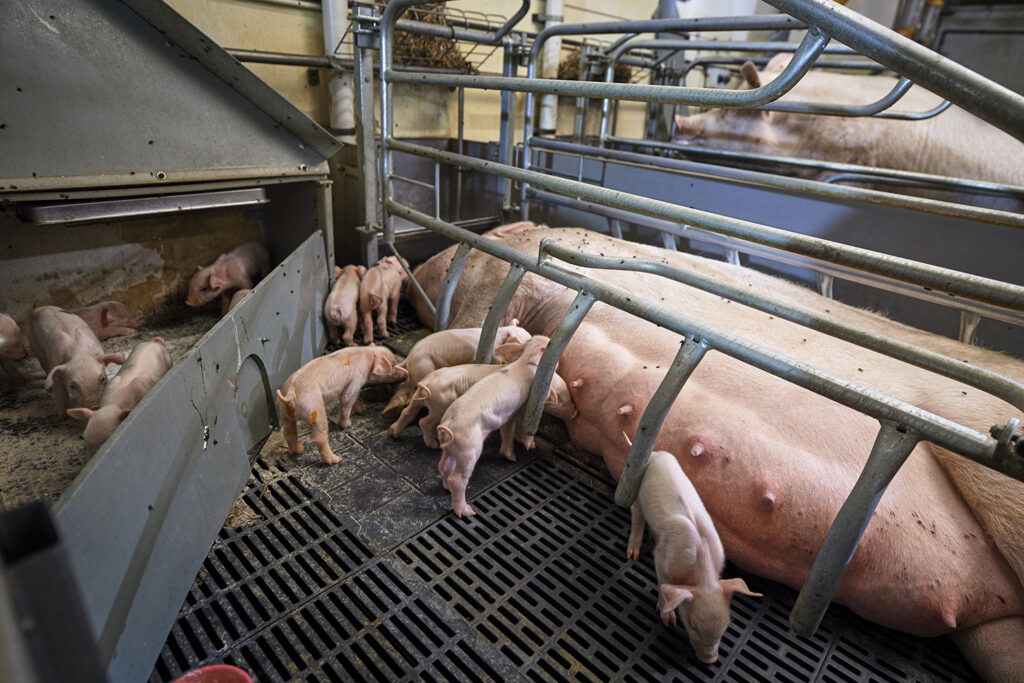Piglet growth – Support colostrum supply
Content
Why all piglets must have colostrum within the first 12 hours
Colostrum is essential for piglet health and growth. Ensuring sufficient colostrum intake during the first 12 hours after farrowing is achieved by a disciplined approach to day 1 care of the piglets.
Adequate supply of colostrum will support health and growth
Success in managing hyper-prolific DanBred sows is especially centred around the careful management of the new born piglets. Newborns are not protected by an active immune system, which means that their health relies on the passive immunity gained from colostrum, making colostrum essential for piglet health and growth. Ensuring sufficient colostrum intake during the first 12 hours after farrowing is achieved by optimising the DanBred sows’ feed intake in late gestation for maximised milk production, as well as a disciplined approach to day 1 pig care in farrowing.
The importance of colostrum intake
Colostrum production starts when the first piglet is born and continues for 24 to 48 hours. Analysis of colostrum has shown that the amount and composition of antibodies in the colostrum slowly starts changing from around 12 hours after farrowing. Within the same time period, the piglet’s ability to absorb the antibodies from the colostrum will start to decrease (Quesnel, 2012). This means that all piglets must have a sufficient amount colostrum within the first 12 hours after birth in order to get the full benefit in terms of health and growth. Additionally, the energy supply for activity and thermoregulation is also very limited in new born piglets, hence why colostrum intake is not only crucial for health it is also essential for the piglets to keep warm and be mobile right after birth (Thorup, 2013).

When managing hyper-prolific sows, it is imperative to master skills such as split suckling and the correct management of foster sows in order to wean as many high-quality piglets as possible. Split suckling, where the smallest 8-10 piglets are allowed to suckle for 30 to 90 minutes, while the bigger piglets are kept in the creep or constrained in another way, has shown to increase survival with 0,4 piglet per litter (Thorup, 2013) Furthermore, the use of foster sows increases both daily gain among all the piglets as well as increasing survival rate among the smaller piglets (Thorup & Nielsen, 2017). In either case it is important to optimise the sows milk production throughout the lactation to maximise the number of piglets nursed by each sow.
Easy steps for managing colostrum intake for optimal piglet health and growth

- Ensure all piglets get access to the udder quickly. Reducing the birth to nursing interval (BNI) is critical to survival.
- Ensure piglets are dried and warmed manually. Drying and warming pigs via towels or drying powder helps the pigs thermoregulation as well as and achieving optimal core body temperature levels.
- Ensure all piglets get at least 12 hours for colostrum intake preferably with their mother.
- Ensure the sow is healthy and in good body condition
Split suckling

Enclose all the piglets within the creep area, behind a board or in a disinfected box, and make sure to provide them with heat (at least 34°C but not above 40°C).
Let the sow get up to eat and drink while all the piglets are enclosed.
- Split the litter into two groups – smaller piglets and bigger piglets.
- Keep the group of bigger, more viable piglets enclosed in a heated zone
- Allow the smaller piglets to suckle for 60-90 minutes
- Mark the start time at the litter card to keep track of time and ensure sufficient suckling time, and mark the pigs which has received colostrum
- Swap the groups over and let the bigger piglets get at least 30-45 minutes of suckling
- Mark the start time at the litter card to keep track of time and ensure sufficient suckling time
- Wash and disinfect the heat box before using it for another litter.
Hand feeding colostrum to piglets
If staff are able, cold or low vitality piglets can be provided with colostrum directly in the mouth from a cup or a disposable syringe. Milk the colostrum from a newly farrowed (within 4 hours) sow in the herd. This should preferably be the mother, but another newly farrowed sow from the herd can be used.
Heat colostrum to 30-35°C (not above 35°C) in a water bath or at low frequency in a microwave oven. Supply a 500 g piglet with 15 mL of colostrum 3 times, with an interval of at least one hour. Supply a 1 kg piglet 30 mL of colostrum 3 times, with an interval of at least one hour.
- Colostrum milked from a sow, has a refrigerated shelf life of 3 days.
- Pack the milked colostrum in portion sizes.
- The colostrum is safe to freeze.
- Be aware of the temperature when thawing.
Foster sows
Foster sows or cross fostering should be used for surplus piglets from big litters.
Ensure all piglets have had colostrum for at least 12 hours before moving them to a foster sow. Remember, split suckling is a tool to effectively get all pigs on a teat and access to adequate colostrum during this initial 12 hours. If a foster sow is needed, choose a sow that is calm, in good health and body condition. 1st or 2nd parity sows are preferred as foster sows, as their teat size will likely match the small mouths of smaller piglets.
References
Råmælk (2017). Online. SEGES Videncenter for Svineproduktion. Retrieved 31/01/19. https://svineproduktion.dk/viden/i-stalden/management/faring/raamaelk.
Thorup, F.; (2013): Splitmalkning af nyfødte pattegrise. Meddelelse Nr. 988. Videncenter for Svineproduktion., den rullende afprøvning.
Thorup, F.; Nielsen, M. F.: (2017): Tilvæksten falder, når de små pattegrise bliver hos egen mor ved kuldudjævning.Meddelelse nr. 1099, SEGES Videncenter for Svineproduktion
Quesnel H; Farmer C; Devillers N (2012): Colostrum intake: influence on piglet performance and factors of variation. Livestock Science 146, 105–114




